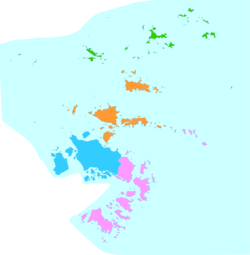Dinghai District
Dinghai
定海区 Tinghai | |
|---|---|
 Zhoushan New Town | |
 Dinghai Distirct is in blue here on the map. | |
 Dinghai Location in Zhejiang | |
| Coordinates (Dinghai District government): 30°01′11″N 122°06′24″E / 30.0198°N 122.1068°ECoordinates: 30°01′11″N 122°06′24″E / 30.0198°N 122.1068°E | |
| Country | People's Republic of China |
| Province | Zhejiang |
| Prefecture-level city | Zhoushan |
| Seat | |
| Area | |
| • Total | 1,444.0 km2 (557.5 sq mi) |
| • Land | 568.8 km2 (219.6 sq mi) |
| • Water | 875.2 km2 (337.9 sq mi) |
| Population (2019) | |
| • Total | 399,382 |
| • Density | 280/km2 (720/sq mi) |
| Time zone | UTC+8 (China Standard) |
| Postal code | 316000 |
| Website | dinghai |
| Dinghai | |||
|---|---|---|---|
| Chinese | 定海 | ||
| Postal | Tinghai | ||
| |||
![]() Dinghai (help·info) (simplified Chinese: 定海区; traditional Chinese: 定海區; pinyin: Dìnghǎi Qū) is a district of Zhoushan City made of 128 islands in Zhejiang province, China. It is based on the larger northwestern half of Zhoushan Island, where it borders Putuo in the east. The district boundary meets that of Daishan County out at sea to the north of the island. Its southwestern boundary intersects the border of Ningbo, also entirely at sea.
Dinghai (help·info) (simplified Chinese: 定海区; traditional Chinese: 定海區; pinyin: Dìnghǎi Qū) is a district of Zhoushan City made of 128 islands in Zhejiang province, China. It is based on the larger northwestern half of Zhoushan Island, where it borders Putuo in the east. The district boundary meets that of Daishan County out at sea to the north of the island. Its southwestern boundary intersects the border of Ningbo, also entirely at sea.
The district, which was formed in January 1987 when it was upgraded from county status, has a population of 399,382 as of 2019.[1][2]
History[]
According to the Dinghai People's Government, the area of Dinghai has been inhabited by humans for over 5,000 years.[2]
During the Spring and Autumn period, the area was known as Yongdong (甬东; 甬東), and belonged to the Yue state.[2]
The area was incorporated as Wenshan County (翁山县; 翁山縣) in 738 CE.[2] In 771 CE, the county was abolished and placed under Mao County (鄮县; 鄮縣).[2]
In 1073, the area was organized as Changguo County (昌国县; 昌國縣), and was placed under the jurisdiction of the Ming Prefecture.[2]
Dinghai County (定海县; 定海縣) was first established in 1688, under the Qing Dynasty.[2]
During the First Opium War, Dinghai was taken by British forces on July 6, 1840.[3] Dinghai was handed back by Charles Elliot, but was subsequently re-captured by Henry Pottinger, on October 1, 1841.[3]
Dinghai was taken by the People's Liberation Army on May 17, 1950.[2]
In October 1958, Zhoushan's prefecture-level status was revoked, and the area became part of Zhoushan County.[2] In April 1962, Zhoushan was restored to prefecture-level status, and Dinghai County was re-established.[2]
In January 1987, Dinghai County became Dinghai District (定海区).[2]
Geography[]

Dinghai District has a total area of 1,444.0 square kilometres, of which, 568.8 square kilometres is land, and the remaining 875.2 square kilometres is sea.[4]
The district spans 128 islands, including Zhoushan Island, Jintang Island, (大猫岛), , , and .[5] Other islands include Changzhi Island (长峙岛) and Panzhi Island (盘峙岛).[4] Many of the islands have hilly terrain, and the highest point in the district is Huangyanjian Mountain (黄杨尖山), which reaches 503.6 meters in altitude.[5]
The area is rich in marine life, with 80 species of fish, and over 150 species of shellfish.[5] The endangered black-faced spoonbill, the yellow-billed egret, the horned grebe, and other species of birds are also native to the island.[5]
Climate[]
The district experiences an average temperature of 16.8 °C.[5] The district's coldest month is January, which averages 6.2 °C in temperature, and the district's warmest month is August, which averages 27.4 °C in temperature.[5] The coldest temperature recorded in the district was −4.2 °C, which occurred on December 28, 1991.[5] The warmest temperature recorded in the district was 40.2 °C, which occurred on July 21, 2007.[5]
Average annual rainfall in Dinghai is 1410.8 millimetres, and the district experiences an average of 149 rainy days per year.[5]
The area experiences typhoons, heavy rains, floods, and droughts.[5] The district was hit by a blizzard on March 12, 2005, which bought the most snowfall to the area since 1978.[5]
Administrative divisions[]



Dinghai District administers consisted of 10 subdistricts and 3 towns.[1][6] As of 2019, these township-level divisions were further divided into 41 residential communities, 73 rural villages, and 7 urban villages.[7]
| English Name | Subdivision Type | Chinese Name | Population (2019) |
|---|---|---|---|
| Subdistrict | 昌国街道; Chāngguó Jiēdào | 54,457 | |
| Subdistrict | 环南街道; Huánnán Jiēdào | 34,874 | |
| Subdistrict | 城东街道; Chéngdōng Jiēdào | 51,578 | |
| Subdistrict | 盐仓街道; Yáncāng Jiēdào | 19,600 | |
| Subdistrict | 临城街道; Línchéng Jiēdào | 46,886 | |
| Subdistrict | 岑港街道; Céngǎng Jiēdào | 18,063 | |
| Subdistrict | 马岙街道; Mǎ'ào Jiēdào | 9,653 | |
| Subdistrict | 双桥街道; Shuāngqiáo Jiēdào | 18,170 | |
| Subdistrict | 小沙街道; Xiǎoshā Jiēdào | 19,802 | |
| Subdistrict | 千岛街道; Qiāndǎo Jiēdào | 39,189 | |
| Town | 金塘镇; Jīntáng Zhèn | 40,074 | |
| Town | 白泉镇; Báiquán Zhèn | 37,144 | |
